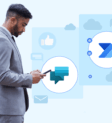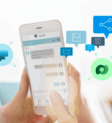Customer Service and Beyond: Harnessing Chatbots to transform the customer experience

We are all aware of how organizations are using chatbots to provide exceptional customer service. Statistics say, “By 2023, more than 60% of all customer service engagements will be delivered via digital and web-service channels, up from 23% in 2019. Impressive, right?
However, if you think that customer service is the only viable use case of chatbots, you may want to re-consider. With the advent and rise of technologies, such as machine learning, artificial intelligence, robotic process automation (RPA), augmented reality (AR), etc., chatbots can be leveraged to lead customers through different stages of the sales funnel.
Research by Tech Republic has found “Teams that use chatbots to automate conversations are 27% more likely to meet rising customer expectations than those that don’t.”
Read the blog to know how chatbots can transform the overall customer experience, beyond just customer service.
Customer Service and Beyond: Harnessing chatbots to transform customer experience
Chatbots can be used to take customers through the entire sales funnel or lifecycle. The customer lifecycle defines the various stages a consumer goes through before, during, and after sales.
They are available 24/7 to help customers with queries, purchases, and product support, anytime and anywhere.
Here’s how chatbots can help create personalized, meaningful, and immersive customer engagement and transform customer experience in each of these phases –
1. Reach
Reach is the first step of the customer lifecycle. Your marketing efforts should be concentrated in places where your customers are to create awareness about your products.
In today’s world, customers demand an omnichannel experience. To generate customer interest around the company’s products and services, organizations can deploy chatbots on channels, such as websites, social media apps, and common messaging platforms like WhatsApp and Facebook Messenger.
Such chatbots can be used to push alerts and notifications about new products, answer customer queries around them, collect data about customer preferences through chats and email, and send personalized tips and advice.
2. Customer acquisition
Reaching potential customers isn’t enough. It is crucial to engage them with the right messaging and personalized product recommendations.
Bots can study customer profiles to make informed and targeted suggestions about what to purchase. Moreover, they can provide suggestions on how to use the product for more meaningful engagement, lead customers to the company’s online store, and assist with payment and checkout.
Examples:
- Quaker Oats

Quaker’s Oats Facebook Messenger bot, Otis, guides customers with online shopping, sets reminders for overnight oats, provides consultation for the queries they raise, and offers delicious recipes.
Users may choose from some of the seasonal recipes available, or type in a food emoji for their preferred item.
This helps the bot guage customer preferences and personalize recommendations for recipes, products, and ingredients.
With Otis, Quaker’s customer engagement has increased 13% year-on-year without any other marketing support.
- POND’S
In 2019, skincare brand POND’S launched its Facebook Messenger bot called SAL that leverages augmented reality (AR) to provide immersive customer experiences. When users upload a selfie, the bot delivers personalized skincare recommendations across four significant areas of concern – pimples, wrinkles, uneven skin tone, and spots.
While the analysis is generated, which usually takes about a minute, the bot shares additional skincare tips to retain the user’s interest.
Upon the completion of the diagnosis, users are informed about their skin condition and offered personalized product recommendations by POND’S.
98% users stated a positive engagement with SAL chatbot.


3. Customer retention
To retain customers, organizations must continue to send relevant and meaningful recommendations and messaging to them.
As a customer interacts more and more with the chatbot, data and feedback collected by the bot can help marketers predict customer needs, analyze, measure, and refine engagement strategies, and develop creative marketing campaigns.
Predictive analytics saves costs as organizations spend less time, money, and effort on developing products that the customers won’t prefer.
Using the chatbot, organizations can then proactively inform customers about latest offers, upcoming sales, complementary products, and upsell/cross-sell products to increase revenue.
In fact, Gartner predicts that by 2025, proactive customer engagement interactions will outnumber reactive customer engagement interactions.
Moreover, quick and accurate customer service using chatbots is one of the most basic ways to increase customer retention.
Examples:

Marriott Rewards members can book travel at Marriott International hotels worldwide on Messenger, handle hospitality-related arrangements, such as business meetings, plan their vacation with the digital magazine Marriott Traveler, and chat with the customer support executives in case of queries.
Additionally, the organization leverages the chatbot to upsell to customers their premium suites and services.
4. Customer loyalty and advocacy
Once retained, customers wouldn’t have an issue recommending the products and services of the organization.
Harnessing chatbots to transform customer experience is one of the surest ways to build customer loyalty, get them to spread positive word-of-mouth about your brand, and build your customer base.
Other benefits of customer-facing chatbots
- Cost Savings – Customer profiling and analysis using chatbots saves costs as organizations spend less time, money, and effort on developing products that the customers won’t prefer. Moreover, chatbots can handle multiple customer queries at once, 24X7, and at scale, allowing customer service agents to focus on more complex customer needs.
- Going local – With multilingual chatbots, organizations can interact with customers in their native tongue. Engaging with customers in their preferred language accelerates localization efforts, allows organizations to understand regional nuances and cultural subtleties, and makes customers feel valued.
How can Acuvate help?
At Acuvate, we help clients deploy AI-enabled chatbots with our enterprise bot-building platform called BotCore.
With minimalistic coding requirements and a graphical design interface, enterprises can build and deploy chatbots customer-facing chatbots within a few weeks. Our bots leverage the best of Microsoft’s AI, ML, and NLP technologies to understand what the customer wants, retain context, learn from past conversations, and provide seamless customer engagement.
Moreover, enterprises can cater to a global customer audience with support for multiple languages like French, German, Italian, English, etc.
To know more about BotCore, please feel free to schedule a personalized consultation with our experts.
Abhishek is the AI & Automation Practice Head at Acuvate and brings with him 17+ years of strong expertise across the Microsoft stack. He has consulted with clients globally to provide solutions on technologies such as Cognitive Services, Azure, RPA, SharePoint & Office 365. He has worked with clients across multiple industry domains including Retail & FMCG, Government, BFSI, Manufacturing and Telecom.






Abhishek Shanbhag